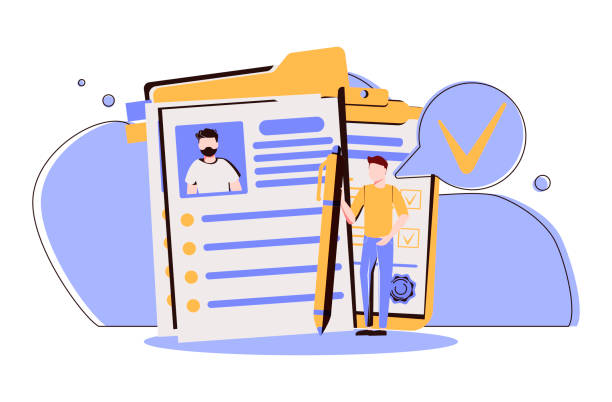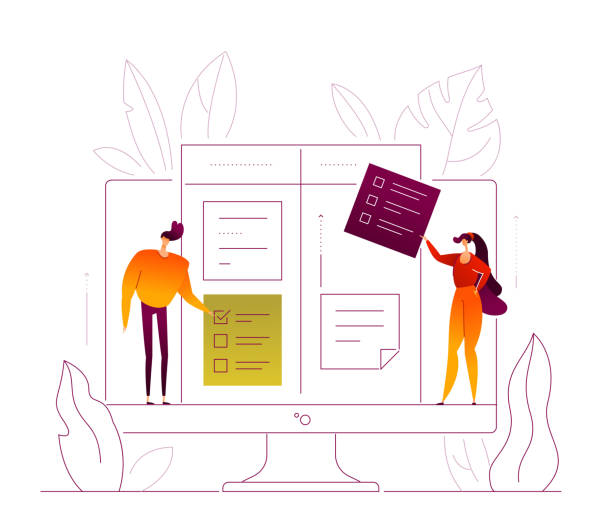An Introduction to Secure Website Design and Its Importance in the Digital Age

In today’s world, where all aspects of our lives are increasingly tied to the internet, secure website design is no longer a luxury option, but an undeniable necessity.
Websites are not only showcases for businesses and information platforms, but also places for sensitive interactions, financial transactions, and storing users’ personal information.
Therefore, #website #cybersecurity and its protection against malicious attacks are considered the most vital principles in the development of any online project.
An insecure website can lead to data loss, violation of user privacy, damage to brand reputation, and even heavy financial losses.
This section descriptively addresses the importance of why every developer and business owner should prioritize secure website design.
Threats such as SQL injection attacks, cross-site scripting (XSS), and credential theft are always lurking, and only by implementing principled and preventive web design can one stay safe from them.
Security is an ongoing process, not a fixed state; therefore, it requires continuous review and updates.
Paying attention to these aspects from the very early stages of secure website design minimizes potential costs resulting from security breaches and builds user trust.
Did you know your company’s website is the first point of contact for 75% of potential customers?
Your website is the face of your brand. With **Rasawweb** corporate website design services, build an online presence that earns customer trust.
✅ Create a professional and lasting image for your brand
✅ Attract target customers and increase online credibility
⚡ Get free consultation from **Rasawweb** experts!
Basic Principles of Website Security for Leading Developers

For any developer intending to work in the field of secure website design, familiarity with the basic principles of website security is a fundamental step.
These principles include a set of best practices and coding standards aimed at reducing vulnerabilities and increasing system resistance to attacks.
Among the most important of these principles is rigorous input validation.
All data sent to the server via forms, URLs, or other external sources must be carefully reviewed and filtered to prevent the injection of malicious code or invalid data.
The use of Prepared Statements in database interactions to prevent SQL Injection attacks, strong password encryption instead of storing them as plain text using hashing algorithms like bcrypt or Argon2, and also proper implementation of Session Management mechanisms are of high importance.
The Principle of Least Privilege for users and processes is also a key principle; meaning that each user or process should only have access to resources that are essential for performing their tasks.
These specialized principles form the foundation of any secure website development, and adhering to them will ensure secure and stable website design.
Continuous training of developers on the latest threats and best practices for countering them is also an integral part of this process.
Identifying and Countering Common Cyber Threats in Secure Website Design

The digital world is full of hidden challenges and threats, and in the path of secure website design, recognizing these threats and ways to counter them is vital.
Attacks like SQL Injection, which allow an attacker to access, modify, or delete data from the database, or Cross-Site Scripting (XSS), which injects malicious scripts into web pages, allowing the attacker to steal cookies or user information, are among the most common types of attacks.
Furthermore, Cross-Site Request Forgery (CSRF) attacks, in which the attacker tricks the user into sending unwanted requests to the server, can have irreversible consequences.
To counter these threats, there are many analytical approaches and practical guidelines.
For SQL Injection, using Prepared Statements and parameterizing queries is essential.
Against XSS, rigorous input and output validation (Sanitization) and the use of Content Security Policy (CSP) are effective.
Countering CSRF is also possible by using CSRF tokens and verifying the origin of the request.
This table provides an overview of common threats and initial countermeasures in the field of secure website creation.
Continuous learning and updating of security knowledge are essential for anyone working in secure website design.
| Threat Type | Brief Description | Main Solution |
|---|---|---|
| SQL Injection | Injection of malicious SQL codes to access the database | Use of Prepared Statements and ORM |
| Cross-Site Scripting (XSS) | Injection of malicious scripts into web pages | Input/output validation and CSP |
| Cross-Site Request Forgery (CSRF) | Tricking the user into sending unwanted requests | Use of CSRF tokens and SameSite Cookies |
| Broken Authentication | Weak or flawed authentication mechanisms | Strong password encryption and MFA |
The Role of SSL/TLS Certificates in Secure Website Design and Earning Trust

In the discussion of secure website design, SSL/TLS (Secure Sockets Layer/Transport Layer Security) certificates play a pivotal role.
These certificates are encryption protocols that secure the communication between the user’s browser and the website server.
When a website uses HTTPS (HTTP Secure), enabled by SSL/TLS, all data transmitted between the user and the server is encrypted.
This means that even if an attacker can intercept the data, they will not be able to read or misuse it.
This is especially crucial for websites that collect sensitive information such as credit card details, passwords, or personal data.
Using SSL/TLS not only ensures data security but also increases user trust.
The green padlock icon in the browser’s address bar assures users that they are in a secure environment and their information is protected.
Furthermore, search engines like Google rank websites with HTTPS higher, which is an SEO advantage.
From a technical perspective, proper SSL/TLS implementation is a specialized part of secure website design that must be carried out with great care.
This includes choosing the appropriate certificate type (DV, OV, EV), correct server configuration, and ensuring the absence of Mixed Content, which can jeopardize security.
Research shows that 80% of customers trust companies with professional websites more. Does your current site earn this trust?
With Rasawweb corporate website design services, solve the problem of customer distrust and a weak online image forever!
✅ Create a professional image and increase customer trust
✅ Attract more sales leads and business growth
⚡ Get free consultation
Password Management and Strong Authentication: A Crucial Step in Secure Website Design

One of the common weaknesses in website security relates to password management and authentication processes.
In the context of secure website design, implementing strong mechanisms for this section is very important.
Weak or guessable passwords are one of the easiest ways for attackers to gain unauthorized access to user accounts.
Therefore, websites should encourage users to use complex passwords including uppercase and lowercase letters, numbers, and symbols, and even make it mandatory for them.
Password storage should also be hashed using strong and brute-force resistant hashing functions like bcrypt or Argon2, not as plain text or MD5.
Furthermore, implementing Two-Factor Authentication (2FA) or Multi-Factor Authentication (MFA) adds a vital security layer.
Even if a user’s password is compromised, the attacker will need a second factor (such as a code sent to a mobile phone or a fingerprint) to access the account.
This approach is a practical and highly effective guide for increasing website security and is considered a fundamental principle in secure website design.
Account lockout policies after several unsuccessful login attempts, as well as notifying the user if suspicious activities are detected, can help prevent brute-force attacks and detect intrusions.
Continuous Updates and Website Security Maintenance: A News Imperative

In the dynamic and ever-changing world of technology, secure website design is not limited to the initial construction phase.
Rather, it requires a continuous and proactive approach that includes regular updates and security maintenance.
This issue has become an important news item in the field of cybersecurity, as many successful attacks occur due to the use of outdated and vulnerable software.
Content Management Systems (CMS) like WordPress or Joomla, web development frameworks, JavaScript libraries, and even the server operating system, all must be regularly updated.
Developers and website administrators must always stay informed about the latest discovered vulnerabilities and released security patches.
Failure to update on time can create large security gaps that attackers can exploit.
In addition to software updates, conducting regular security audits, Penetration Testing, and Vulnerability Scanning are other important aspects of security maintenance.
These analytical measures help identify weaknesses before attackers discover them.
Regular and secure data backups are also vital so that the website can be quickly restored in the event of any security issue or attack.
This proactive approach significantly helps in maintaining website security over time and ensuring the stability of secure website design.
Database Security and Protection of Sensitive Information in Secure Website Design

The database is the heart of any website, housing valuable and often sensitive user information.
Therefore, in the process of secure website design, database security is of particular importance.
Protection of sensitive information such as usernames, passwords, financial data, and personal information must be a priority.
One of the first steps is the encryption of sensitive data in the database, especially those containing identity or financial information.
Using strong encryption algorithms and securely managing encryption keys is essential.
Furthermore, implementing precise Access Control mechanisms for database users, including assigning the principle of least privilege to each user or application, is an important specialized principle.
For example, users who only need to read information should not have write or delete privileges.
| Security Measure | Description |
|---|---|
| Data Encryption | Encrypting sensitive information at rest and in transit |
| Precise Access Control | Applying the principle of Least Privilege for users and applications |
| Updates and Patching | Keeping the Database Management System (DBMS) up to date |
| Regular Backups | Performing regular and secure backups for recovery when necessary |
| Monitoring and Logging | Monitoring database activities and logging security events |
Also, monitoring database activities and logging for identifying unusual patterns and intrusion attempts is very important.
Regular and secure backups of the database are also a necessity so that data can be restored in case of an attack or system failure.
Placing the database in an isolated network behind a firewall and ensuring no direct public access to it are also important measures in securing the website.
These analytical and explanatory approaches form the backbone of any secure website design.
Facing DDoS Attacks and Effective Defensive Strategies

Distributed Denial of Service (DDoS) attacks are among the most disruptive types of cyberattacks that can take any website offline, thereby disrupting user access to services.
In the process of secure website design, planning to deal with such attacks is vital.
DDoS attacks overload the target server’s resources by sending a massive volume of fake traffic, causing the website to become unavailable.
These attacks can be carried out through botnets, which consist of thousands of infected devices.
To counter these threats, various defensive strategies exist.
Using Content Delivery Network (CDN) services like Cloudflare or Akamai, which can filter malicious traffic before it reaches the main server, is highly effective.
CDNs also reduce traffic load and increase website stability by distributing content across various geographical servers.
Implementing Web Application Firewalls (WAFs) can also help identify and block suspicious traffic patterns.
Furthermore, having an Incident Response Plan for DDoS attacks, including detection, containment, eradication, and recovery phases, is essential.
This section analytically discusses the importance of readiness against such attacks and the implementation of practical guidelines for increasing website resilience against them.
Secure website design must include these defensive layers to ensure continuous user access.
Don’t have a corporate website yet and missing out on online opportunities? With professional corporate website design by Rasawweb,
✅ Double your business credibility
✅ Attract new customers
⚡ Free consultation for your corporate website!
User Education and Security Awareness: An Entertaining Approach

While secure website design is technically very important, the role of end-users in maintaining security should not be overlooked.
Many security breaches result from human error; therefore, user education and security awareness are a vital and even entertaining but very important aspect.
This section instructively teaches users how to have safer online behaviors.
Topics such as identifying phishing attacks, where attackers try to obtain sensitive user information by impersonating others, should be clearly explained.
Websites can use friendly educational messages, engaging infographics, or even small interactive games to inform users about the importance of using strong and unique passwords, activating two-factor authentication, and not clicking on suspicious links.
Encouraging the use of Password Managers can also help users remember complex passwords.
Furthermore, raising awareness about Social Engineering attacks, where attackers deceive individuals to obtain confidential information from them, is essential.
A secure website is not just a product of secure coding, but also the result of responsible user interaction.
By turning security education into an informative and engaging experience, we can promote a stronger security culture in the online community and ultimately achieve a more secure and comprehensive website design.
The Future of Secure Website Design and Upcoming Challenges

As technology rapidly advances, the landscape of security threats is also constantly changing.
Therefore, exploring the future of secure website design and the upcoming challenges in this field has become a thought-provoking and analytical content.
One of the most significant developments is the emergence of Artificial Intelligence (AI) and Machine Learning (ML), which can be used both as powerful tools for enhancing security (e.g., detecting anomalies and advanced attacks) and as tools for attackers to develop more sophisticated attacks.
Quantum computing also poses a long-term challenge to current encryption; as quantum computers will be able to break many of today’s encryption algorithms in a short time.
This requires the development of new post-quantum encryption algorithms.
This analytically creates new challenges for secure website design in the near and distant future.
Furthermore, the increasing use of the Internet of Things (IoT) and inter-device communications expands the attack surface and creates new vulnerabilities for attackers to exploit.
New privacy regulations like GDPR or CCPA also affect how data is collected, stored, and processed, requiring new approaches in secure website design with Privacy by Design.
Preparedness for these challenges and investment in research and development of innovative security solutions are of high importance to continue building secure websites in the future.
Frequently Asked Questions
| Question | Answer |
|---|---|
| What is secure website design? | Secure website design is a process in which websites are built considering security principles to be resistant to cyberattacks and protect user and business information. |
| Why is secure website design of high importance? | To prevent unauthorized data access, sensitive information leaks, malware attacks, loss of user trust, damage to business reputation, and legal consequences resulting from data breaches. |
| What are the most common website vulnerabilities? | SQL Injection, Cross-Site Scripting (XSS), Cross-Site Request Forgery (CSRF), broken authentication and session management, and sensitive data exposure. |
| How can SQL Injection attacks be prevented? | Using Prepared Statements with parameterized queries, Input Validation, and restricting database access. |
| What are the methods to counter XSS (Cross-Site Scripting) attacks? | User Input Validation, Output Encoding before displaying in HTML, and using Content Security Policy (CSP). |
| What is the role of HTTPS in website security? | HTTPS, using SSL/TLS certificates, encrypts the communication between the user’s browser and the website server, preventing eavesdropping, tampering, or forging of data. |
| What are the best practices for managing user passwords? | Enforcing strong passwords (a combination of letters, numbers, and symbols), hashing passwords instead of direct storage (with strong algorithms like bcrypt), and enabling two-factor authentication (2FA). |
| What is the importance of User Input Validation? | Input validation prevents malicious or unexpected data from entering the system, which can lead to vulnerabilities such as SQL Injection or XSS. |
| What impact do regular security reviews and audits have on site security? | These reviews help in early identification of vulnerabilities and security weaknesses, enabling their remediation before they can be exploited. |
| What is the application of Web Application Firewall (WAF) in secure website design? | A WAF acts as a protective layer between the user and the website, analyzing incoming traffic, and identifying and blocking common web attacks like SQL Injection and XSS. |
And other services of RasaWeb Advertising Agency in the field of advertising
Smart Digital Advertising: A professional solution to increase website traffic with a focus on optimizing key pages.
Smart Marketing Automation: Designed for businesses seeking user engagement through intelligent data analysis.
Smart Google Ads: An effective tool to increase website traffic with the help of marketing automation.
Smart Advertorials: A blend of creativity and technology for digital branding through key page optimization.
Smart Social Media: A professional solution for analyzing customer behavior with a focus on intelligent data analysis.
And over hundreds of other services in the field of internet advertising, advertising consultation, and organizational solutions
Internet Advertising | Advertising Strategy | Advertorial
Resources
- Tabnak Cyber Security News
- ITC Web Security Articles
- Zoomit Web Security Topics
- Beytoote Computer and Network Security
? In the fast-paced digital world, Rasawweb Afarin Digital Marketing Agency, with its expertise and experience, is the guide to your business success. From personal website design to comprehensive digital campaigns, we are by your side to ensure a powerful and impactful online presence.
📍 Tehran, Mirdamad Street, Next to Central Bank, Southern Kazeroun Alley, Ramin Alley, No. 6




